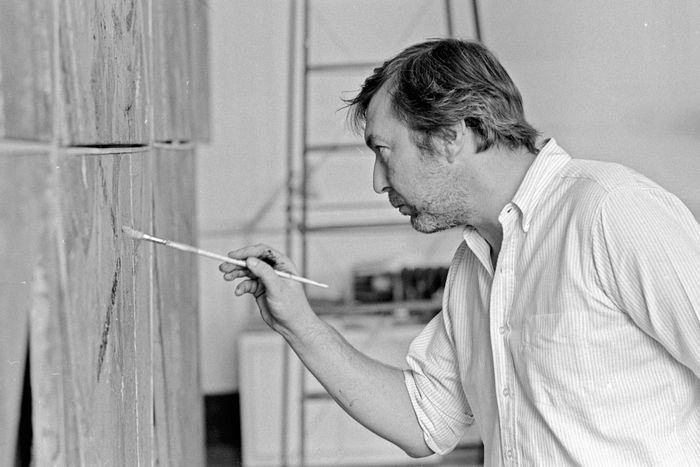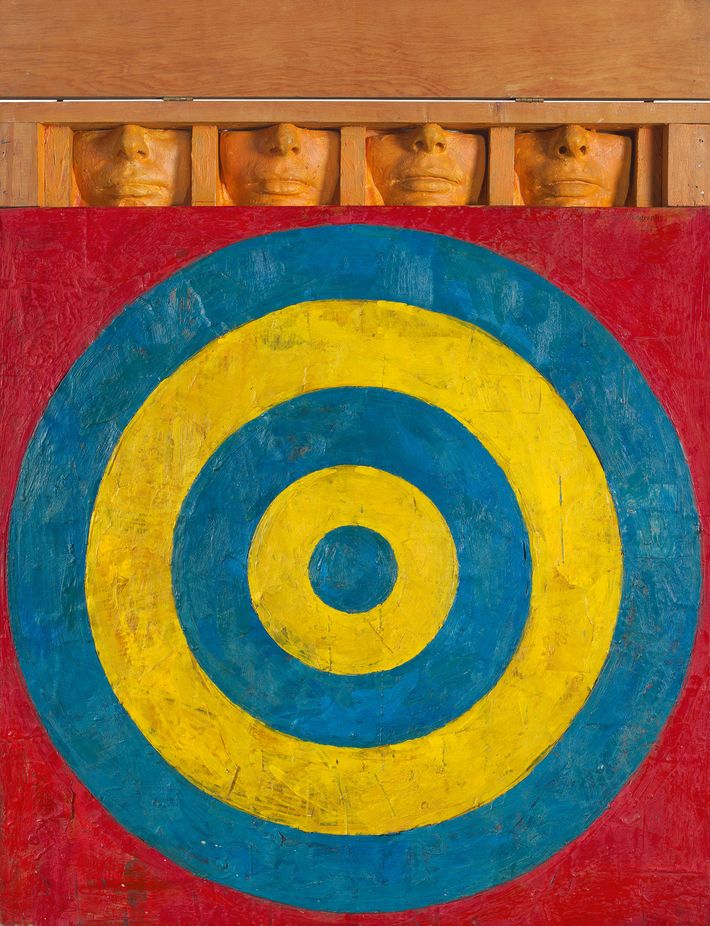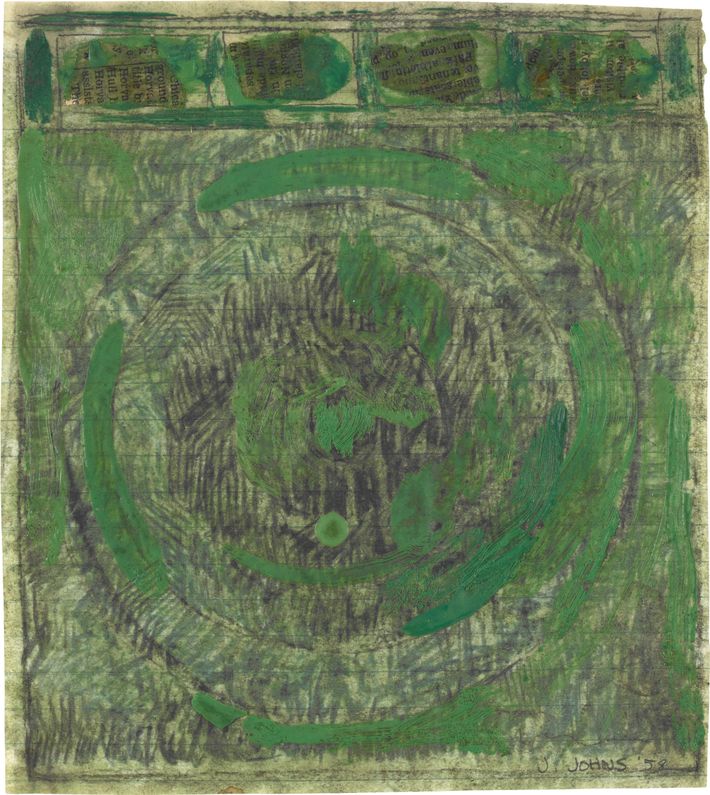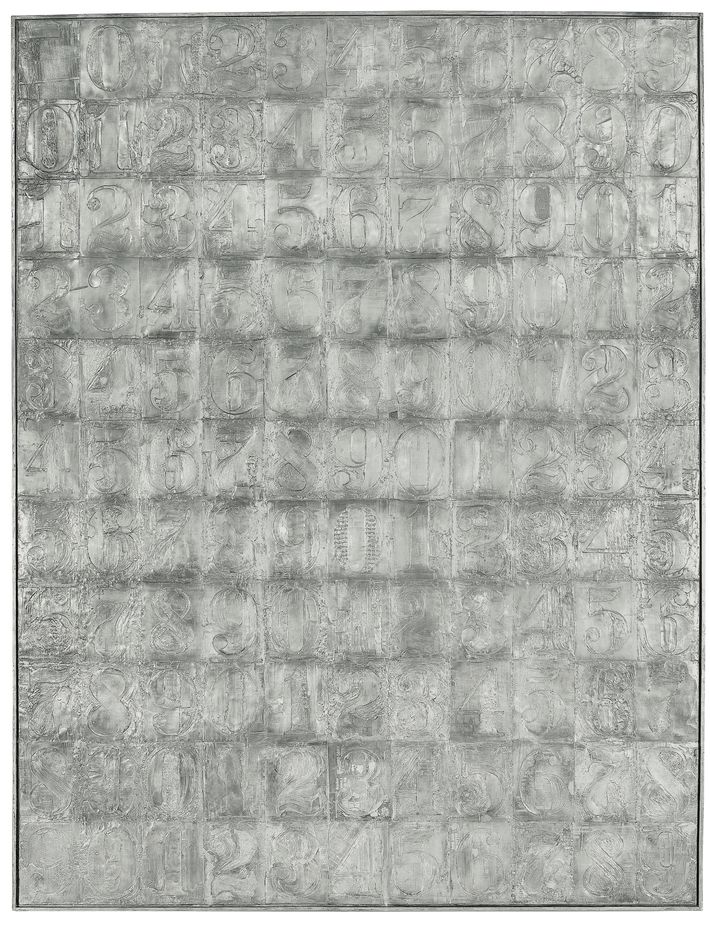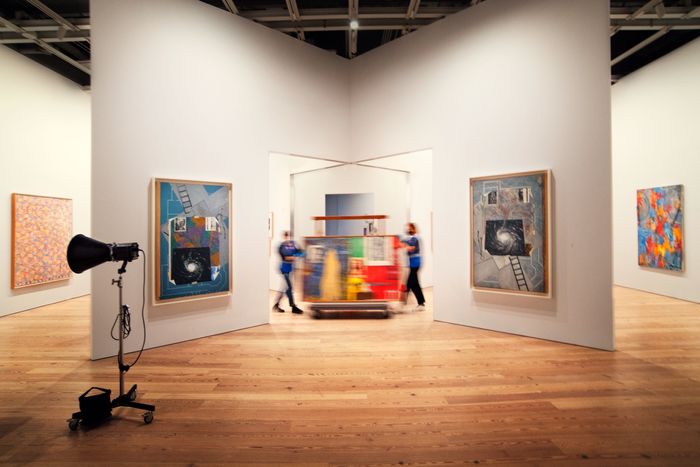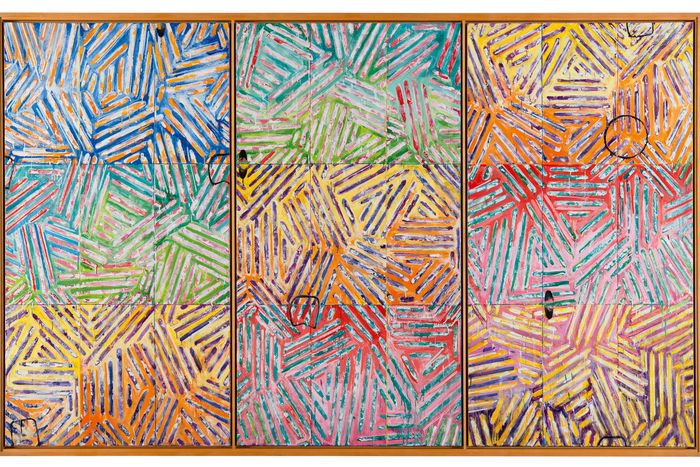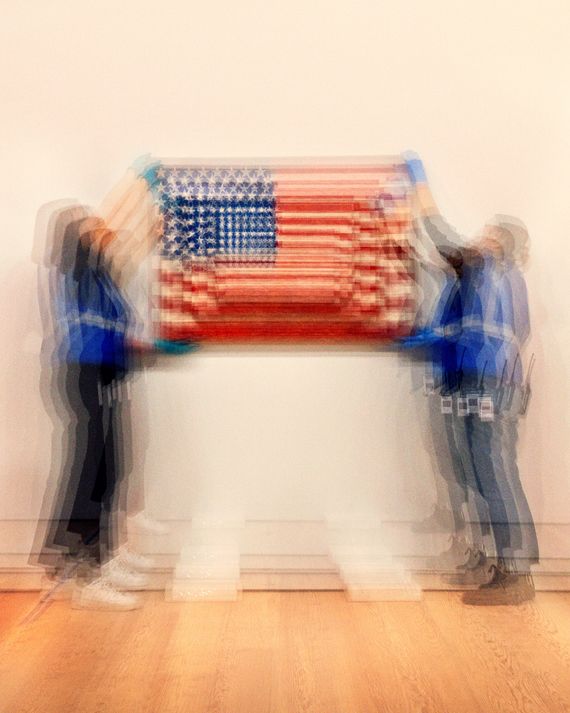
One night in 1986, while standing at the top ramp of a Guggenheim Museum opening as an art-world wannabe, peering down at this social universe that seemed so distant and magical to me, I found myself standing next to an older man. He seemed to be doing the same thing. Both of us were in our own worlds. After a while, he turned at me and said, “Hello, Jerry.” I was surprised. I looked at him blankly. After a pause, I said, “I am sorry. What is your name?” He said, “My name is Jasper Johns.” It was a perfect picture of my unchecked egoism and his imperturbability, modesty, and honesty. And he answered exactly what I asked. It felt like proof that by then, Johns was being seen as an outmoded artist from another era. He was only 56.
Johns had made his mark not as a throwback but as a genuine revolutionary — one of the biggest in American art history. For a full century before, beginning with the Impressionists, cresting with Picasso, and reaching a sort of endpoint with the Abstract Expressionists, most of whom were a few decades older than Johns, the making of art was ruled by the principle of purity and the vision of the artist as a history-bending shamanic genius. Johns initiated a new century, still ongoing, in which works could be purposefully impure, imperfect, and connected to the things of the world, while also being serious philosophical machines. In this, he had predecessors, like Marcel Duchamp and Yves Klein, and successors, like Andy Warhol, Gerhard Richter, and even Jean-Michel Basquiat. But the real track-jump happened, or started, with Johns — in part because, ironically, in rejecting self-consciously iconic grandiosity, he produced what turned out to be among the most iconic, if largely impersonal, works in all of art history. This is why Ed Ruscha called Johns “the atomic bomb of my education.”
In the fall of 1954, the 24-year-old, who had been laboring on muddy vaguely Abstract Expressionist–influenced works, effectively burned his artistic ships and destroyed all of his previous work. “I decided to stop becoming, and to be an artist,” he said. “If you avoid everything you can avoid, then you do what you can’t avoid doing … You do what is helpless, and unavoidable.” The word helpless is a key to his work.
Not long after destroying his art, he woke up one morning and said, “I dreamed that I painted a large American flag. The next morning, I got up and I went out and bought the materials to begin it.” The result is Flag, the most iconic, transgressive object/amulet in late-20th-century American art. Soon, the enamel house paint he was using “wouldn’t dry quickly enough,” so he switched to a technique he had “read or heard about.” This is encaustic, a wellspring of much of the look of all his art that is an ancient technique used in Egyptian faiyûm portraits and Roman painting. It is a sensuous fast-drying mix of heated beeswax and pigment that preserves every brushstroke in creamy, streaked, sluiced pentimento. Artist Mel Bochner talked about “the ‘dark side’ of Eros” in Johns’s work. This is where it lies. In Johns’s surfaces, you glean every mark, touch, over- and underpainting, decision, and erasure. The medium marbleizes and congeals as you look at it, seemingly retracing and preserving his moves. You are almost in his body, witnessing the morphological development of a work of art. Johns becomes a scribe incising clay, making his own abstract cuneiform tablets. The effect is spooky, somnambulant, lulling, hallucinogenic, and pleasurable — what Richard Serra meant when he said you see Johns’s art “millimeter by millimeter, second by second.” Johns is helping us to see time.
Johns remarked that Flag took “a long time” to paint. He has also called it “a very rotten painting — physically.” What he meant is that the different paints were applied to an unstable surface. Since his mind was helpless to slow down his thinking and seeing to the speed of enamel, he had to speed up the paint. Flag is a triptych of panels and isn’t the proportions of a “real” flag. The work’s surface has been built, collaged from newspapers, headlines, bits of print, ads, and the like. The writing visible through the translucent encaustic has “no significance to me,” Johns said. View Flag as a paradox: something in which contradictory truths are revealed. It is iconic and ironic; a real thing and a fake; painterly and awkward; visually blistering and psychically cocooned; patriotic and subversive; a new form of beauty made of old forms; drop-dead obvious and forever at a distance.
I think Johns’s dream was partly inspired by “the first person I knew who was a real artist.” This was Robert Rauschenberg, whom he met in 1954. The two became lovers. The Texan described Johns as “soft, beautiful, lean and poetic … he was always an intellectual … he would read Hart Crane’s poems to me.” Rauschenberg brought Johns into his world of artists like Josef and Anni Albers, Cy Twombly, Buckminster Fuller, Franz Kline, Dorothea Rockburne, Willem and Elaine de Kooning, and Merce Cunningham (Johns called him “my favorite artist in any field”) and the dancer’s partner John Cage — who called the couple “the Southern Renaissance.” It is no exaggeration to say this circle totally remade American culture at its very mid-century peak. The artists of the previous generation, many of whom had escaped Europe for America, were serious and committed to the project of Modernism — art as a cause that amounted almost to total war. By 1954, that war no longer mattered to an upcoming generation. While almost all the Abstract Expressionists were straight white men (de Kooning called himself “cunt-crazy”), the younger artists included more women and a lot of gay men. Of course, they were still extremely white.
Johns has always acknowledged Rauschenberg as the nuclear furnace of it all. “I learned more about painting from Bob than I learned from any other artist or teacher.” One critic remembered Johns saying that “Rauschenberg was the man who in this century had invented the most since Picasso.” Indeed, Rauschenberg is the American Picasso. Or at least our Gertrude Stein — which would make Johns, effectively, Hemingway. Rauschenberg said that he and Johns “started every day by having to move out from the almost overpowering influence of Abstract Expressionism.” If Abstract Expressionist art was big, existential, emotional, serious, and about the “sublime,” their work would be smaller, figurative, vernacular, more ironic, profane, made from everyday materials, made from life. It was like they were renaming all the animals.
For all effective purposes, on the night of March 8, 1957, Modernism ended and contemporary art began. Composer Morton Feldman brought husband-and-wife art gallerists Leo Castelli, 49, and Ileana Sonnabend (then Castelli), 42, to Rauschenberg’s studio. The two immigrants were about to become the deans of a new American avant-garde. They already loved Rauschenberg’s work. That night, Castelli mentioned that he had just seen a green painting of a target in a group show. (This was Johns’s Green Target.) Rauschenberg told them that the artist lived downstairs. “I must meet him,” said Castelli. Rauschenberg returned with Johns a few minutes later. The two dealers went to Johns’s studio.
In the studio, they saw different flags, targets, numbers, letters, and more. Sonnabend bought Figure I, a numbers painting, on the spot. Castelli told the best chronicler of the period, Calvin Tomkins, that the first time he saw Green Target, “I was thunderstruck … I saw evidence of the most incredible genius.” He said it was like wanting to “get married.” Castelli offered Johns a show at his new 4 East 77th Street gallery. Rauschenberg seemed excited for Johns. Several days later, however, “in a state of near despair,” Rauschenberg visited the gallery and asked if he would get a show. His exhibition was scheduled for two months after Johns’s. American art history was about to jump the tracks.
The month that Johns’s first solo show opened, the best art magazine of the time, Art News, featured his Target With Four Faces on the cover of its January 1958 issue. This was unheard of at the time. On Monday, January 20, 1958, Johns’s debut solo show opened at Castelli’s gallery. Five days later, Alfred Barr, the MoMA’s director of museum collections, arrived with MoMA curator Dorothy Miller at Castelli. By day’s end, they had arranged for MoMA to purchase Green Target and Flag (for $1,000 each), Target With Four Faces ($700), and White Numbers ($450). Flag was acquired as a promised gift by Philip Johnson because the curators feared museum trustees would reject the work as communistic and unpatriotic. It was a sellout show. By contrast, Rauschenberg’s show saw just two sales, one of which was returned. Castelli bought Bed for $1,200 and in 1989 gave this absolute masterpiece to MoMA; it was by then valued at as much as $10 million.
Johns makes his art, he has said, from “things the mind already knows” and “things which suggest the world,” things “seen and not looked at, not examined.” For Johns, this means flags, flagstone patterns, silverware, cast body parts, sign language, and images of the Mona Lisa and existent systems like maps, numbers, and the alphabet. He lets you see these things and simultaneously allows us to see how things “can be one thing at one time and something else at another time,” or “one thing working different ways at different times.” I hear echoes of Wallace Stevens’s “Nothing that is not there and the nothing that is.”
But by 1968 he had changed his work several times, each time radically. The year after his debut, he created garish abstract paintings, some with sticks attached that seem to have been used by the artist to inscribe a circle (a painting that shows its own making); he stenciled names of colors atop other colors that toggle in the mind between seeing and thinking; he attached a thermometer to work and painted numbers around it. In 1960, Johns heard that de Kooning was so steamed about Castelli’s new gallery and all the sales that he said, “You could give that son of a bitch two beer cans and he could sell them.” Johns commented, “I thought, What a wonderful idea for a sculpture,” and made a painted bronze of just that. It’s Pop Art before it existed, Warhol’s Brillo Boxes years before the fact. The simple geometric seriality and oneness of this sculpture also triggers minimalism, not to say conceptualism. It is an American version of Méret Oppenheim’s fur-lined teacup. Soon Johns had attached a broom, a tin can, and a spoon to different works. By the 1970s, he was making huge paintings with chairs, wax hands and feet, hangers, other paintings affixed face-down on-the-canvas, wire, or painted flagstone patterns.
In the mid-1970s, Johns stopped making art out of “things the mind already knows” and began making a more inward, arcane, convoluted art — “things my mind already knows,” you could say. Tracings of paintings he liked, patterns that caught his eye, prints of his own body and genitals, illustrations of insects, favorite pieces of pottery, and much else. From about 1981 onward, you see his art in parts, not all at once: details; shapes within shapes; the eye changing focus, moving about a work, never centering, never knowing what one is seeing.
Johns has always worked alone, and keeps changing, taking steps forward and back. His career too is a paradox. While artists everywhere were setting up huge studios with assistants making their work to meet the never-ending demand for similar-looking product, he was on his own koanlike island; a foundational but castaway artist, almost on another planet. He got off the art-historical train of isms. This expanded his art, for me. For the art world, however, the hull integrity of his artistic wholeness collapsed. He was seen as an eccentric or lost. This gives his career an arc of atavism and abnegating tragedy, a willful artist hopelessly at the mercy of his obsessions.
“Jasper Johns: Mind/Mirror” is the largest retrospective ever mounted of this Ur-artist at the center of the late-20th-century art labyrinth. It contains over 500 works and is split between the Whitney Museum of American Art and the Philadelphia Museum of Art. The show shines for not being your parents’ Jasper Johns show. Rather than art-for-rich-people, the usual march of the masterpieces, or endless bellybutton-gazing exegesis and historical analysis and interpretive study of all his images, “Mind/Mirror” is a much-needed close-read, experimental new geography of this artist who created his own private cork-lined bedroom and orchidology of art. It gives us a deeper, more complex artist who is so committed to his materials that we see, as one of Oscar Wilde’s characters had it, a “mind expressing itself under the conditions of matter.” As Johns put it, “The medium expresses itself to you by what it is” — free of language that makes your mind work in different ways — and allows you to see things in multiple ways. I advise viewers to surrender to it.
It sounds like an evasion, and maybe it is. In his introduction to the show, Scott Rothkopf writes that Johns “has been considered an important — if not the most important living artist for more than 60 years.” (I left the show thinking, He is.) Yet, his critical reception hasn’t been a walk in the park. When Johns was still in his 30s, artist-critic Sidney Tillim opined that he was already in “decline,” calling him “a facile technician” who “has become a little seedy.” Tillim is referring to Johns’s work breaking up into parts, things that don’t add up, that are impure, that are no longer singular things like maps, targets, numbers, etc. Mark Rothko complained, “We worked for years to get rid of all that.” He meant representation, unserious things and objects from the world. (Johns’s art was not drawn from the existential self and dark nights of the artistic soul.) Leo Steinberg, among Johns’s greatest eventual apostles, wrote, “It looked to me like the death of painting, a rude stop, the end of the track.” One prominent abstract painter attending his first show raged, “If this is painting, I might as well give up.” We see the impact Johns had on peers when Serra observed, “He presented a new model. There was an abrupt shift. It was sort of like the Beatles kicking out Elvis.”
The first Johns show I ever saw in the flesh was the 1984 Leo Castelli exhibition, where I witnessed an artist being reborn. Here were crosshatch paintings begun in the 1970s, now seemingly put through an abstract blast furnace that produced compression ruptures and expansion cracks across what looked like broken ice sheets. The crosshatch pattern came from a car he saw while driving: “I only saw it for a second, “but knew immediately that I was going to use it … [It had] literalness, repetitiveness, an obsessive quality, order with dumbness and the possibility of complete lack of meaning.” While this “dumbness” etc. echoes Warhol, in Johns it comes from a more eccentric, personal, unknown, unknowable place. The embrace of these more feral artistic values opened a huge window for me.
But by the early ’80s artists used Warhol, Richter, and Judd as starting points, not Johns. Theory-heavy postmodernism ruled the art roost. (I didn’t understand this stuff either and am still playing catch-up.) This meant cool art about art, slick execution, self-conscious statements on other self-conscious statements, discourses of photography and mechanical reproduction. Meanwhile, Johns was almost embalmed in pious writing that could find no wrong in him.
In the 1990s, the critical roof fell in. After paying tribute to the artist in his review of the MoMA’s 1996 Johns retrospective, New York Times’ then-chief art critic Michael Kimmelman, wrote the work was “self-mythologizing … preening obscurantism … rambling … sanctimonious.” By then, Johns was using encaustic less and his surfaces were growing flatter, duller, and were not as sensual. His imagery was multiplying as he recycled and branched out at the same time. The work got much more coded, which set off thousands of wild-goose chases looking for the meaning of it all. Writing on the occasion of Johns’s 2005 gallery show, at Matthew Marks, my good pal the critic Peter Schjeldahl called his work “arch … self-imitative … undernourished and overthought.” The art critic Clement Greenberg once wrote, “my experience of Johns — contains nothing that justifies the term major.” It is true. These works are no longer even about “majorness.” They are personal workings, explorations, platforms for ideas, occasions for experience, fleeting, silent. I see silence as a force and take comfort in John Currin saying, “Major genius is inaccessible.” All this reminded me of how Contemporary Christian music of that period could have no ambiguity and had to be clear, declarative, and unironic. I hear a pitch of viciousness and grievance in the criticism. Or maybe I’m just a prig keeper of the Johns flame.
I know Johns a bit, mostly secondhand, through friends. My wife, Roberta Smith, and I have dined with Johns twice in his Connecticut home. Both lunches were cooked by him and were fantastic. At the first meal, Roberta shattered him into laughter by describing a lyrical loopy shape in a late de Kooning as “the Flying Nun.” I spent much of my time noodling around, studying what art he owned. I seem to recall Diane Arbus’s 1967 Identical Twins. The next time we had lunch, he and Roberta entered a space-time warp talking about “God.” Not the entity but the 1917 readymade sculpture titled that — a twisted configuration of plumbing by the American artist Morton Schamberg (1881–1918). The two went on for 90 minutes parsing the work and then talking about how they thought that it should be co-attributed to the Baroness Elsa Hildegard von Freytag-Loringhoven (1874–1927). (This attribution, once debated, is now officially recognized.) I watched the two seem to pick artistic nits off one another, drilling into the minutiae and pleasures of this period. Listening to these obsessives was like hearing the ocean rolls of an art history that have helped my work ever since.
I’ve had scores of small dinners with him in other people’s homes. Each time I’m around him, I feel a kind of tidal force. He is much taller, larger than you might imagine. Every time. He is witty, articulate, patient, curious, thinks of things in almost microscopic detail, is generous with information, a great story- and joke teller. He is interested in everything — nature, politics, poetry, ceramics, plants, plays, history, movies, dance, cooking, whatever comes up. I don’t think that I have ever heard him swear. The only time he asked me not to talk about something is when someone asked me ten years ago to talk about my time on a reality-TV show about art. He turned to me and simply said, “Please, Jerry. Don’t.” I didn’t. He exudes dignity, magnanimity, poise, circumspection, and inwardness, and he doesn’t bear fools well. He’s often described as cryptic, difficult, taciturn, or distant. I’ve seen very little proof of this. Some say he can be sharp. Many claim he’s this cloistered Scrooge-sphinx who’s spent the last 30 years living hermitlike in Sharon, Connecticut. This is flat-out wrong. He goes out often, drives himself everywhere, and has one of the best senses of humor and irony I’ve ever witnessed and the best blasting laugh. It’s like an eruption of joy released. After he became aware that an assistant had been stealing and selling his art, I remember a cloud of remorse around him in the aftermath of having to let this person go. Betrayal, for him, seems to elicit powerful feelings.
He is the most precise speaker I have ever heard. Any question put to him, no matter how trivial, vain, or bizarre, elicits a pause. You feel him slowly turning over your words in his mind, seeing exactly what you asked in different ways, thinking, weighing the emotional tenor of his answer and the information to be given. In these pauses, I’ve seen the air go out of dinner parties as the table falls silent. I’ve heard my own heart pounding in those silences. Then he always answers with a short, very specific, direct response. In these responses, I almost always perceive in whatever question he’s been asked parts of it I had not noticed before. How a question is worded will change his answer altogether. Someone I know slightly told me he once rang Johns’s Connecticut buzzer and asked “Is this Jasper Johns’s home? May I come in?” Without missing a beat, Johns replied, “Yes, it is, and no, you may not.” Recently, I asked, “How are your knees?” After a moment of thinking, he said, “Much as they were yesterday.” This isn’t to say that sometimes he doesn’t come off as a perverse Zen master.
Then, too, I’ve seen him withdraw at a dinner, disappear for long moments. To leave, he simply will stand up and say, “Thank you. Please don’t get up. It is time for me to leave.” He never fails to thank his host. He has about the best manners I have ever seen. Being around him in these settings conjures a Proustian world where personages become great, small talk reveals large things, social faux pas become apparent, everything takes on a lightness of being but also some weight.
The reports of him being “difficult” stem, I think, from his being asked the same set of questions for more than a half-century. “Why did you paint this?” “What does so-and-so mean?” “Where does this image come from?” “Can you talk about being gay?” “How did you come to paint Flag?” “Tell me about your breakup with Rauschenberg.” “What’s that green-angel shape in all those paintings?” It reminds me of what Who drummer Keith Moon said about always being asked about the rock opera Tommy: “I’m fed up with talking about it; I’m certainly not fed up with playing it.”
I have a few Johns anecdotes. The first is the worst. I asked one of those Flag questions. I’m still mortified by it. In 2003, at MoMA, I had a mini-revelation while looking at Flag. Near the lower left-hand star, I saw something I’d never seen before and didn’t recall anyone ever writing about. There, stenciled, are the words “United States” in the star field. I went home, studied other flag paintings and prints. Sure enough, the same words or outlined shape are there every time. I was electric.
I couldn’t wait to see him again. I waited for a chance to get him alone. Over cocktails, I heard these horrific words come out of my mouth: “Why did you paint the words ‘United States’ on Flag?” He stopped for a moment. I thought I gleaned a look in his eyes that said, “Jerry!” But there was a crick of a smile at the corner of his lips that also told me that it was okay, as he seemed to take a trip into himself and made me know I hadn’t been abandoned, that he was actually thinking of this, and in this way I was granted the momentary delusion that we had merged. Then he said, “Well, those words must have been there, so I left them there.” These were the manufacturer’s stitched or printed letters that were on the flag. Obviously, he’d rendered what was there, no more and no less. His answer revealed that had I thought a bit more, paid attention to the work, and his work in general, the answer was already known. I knew too, on a deeper level, that the reasons I didn’t go inside myself were that I wanted to seem special to him, strike him as smart, show-off, assume an intimacy and natter at dinners ever after about my “brilliant” Flag story. Johns’s work makes you come to terms with your own lazy angels.
I have never seen anyone look at art as closely as he does. At a 1993 Pace Gallery de Kooning–Dubuffet exhibition, I got off the second-floor elevator and spied him across the room studying one de Kooning painting. He didn’t see me. We were alone in the gallery. I thought, I won’t disturb him. I’ll walk around the opposite direction, super-slow, and show him how hard I look at art. I surmised we’d bump into one another and then, feigning my surprise as we met, discuss these artists. I moved slower than I ever had before in my life. I never glanced back at him. After an hour, I made it all the way around the gallery. As I prepared to look up and see him, I turned around and saw that he hadn’t budged an inch and was still studying the same painting. It was mystifying, stupendous. This may be why he sees shapes, patterns, configurations, figures, fragments, visual coincidences, contiguities, details, and geometries in ways others never have, or he has an extra wrinkle in his temporal lobe.
I have seen him look at things this way many times. One time, he visited my wife and me at a large rustic 19th-century mountain camp we rented that had no running water, electricity, and was lit by oil lamps. All the original furnishings were still in place. The mildewed rugs, wainscot walls with paper pasted on them to keep out the cold. As we toured the house, he looked at every single piece of furniture, fixture, detail, old picture, magazine from the period, plate, rug — everything. Even the “tasteful” wildflower bouquets I placed nonchalantly about the house. Rather than the usual ten-minute house-proud tour, this one took two hours. I handed him off to Roberta. The two joined the rest of us for lunch long after we began eating. No one batted an eye. All had seen him do this before. Much later, a friend told me he thought Johns returned alone when we weren’t there. He speculated that this almost ghost house reminded Johns of where he was born in Georgia, abandoned by his divorced mother and father (an alcoholic farmer), sent to live in South Carolina with a paternal grandfather, then with an aunt, then with his mother and a stepfather. Of his childhood, he has said it “wasn’t specially cheerful.”
What else? In 2010 at the MoMA preview of Abstract Expressionist New York, I spotted him looking at the show — very, very slowly — with one of the MoMA’s chief curators, Ann Temkin. I waited for him to leave and approached Temkin. I said, “Ann, can you tell me what he thought?” She laughed, looked at me incredulously, and gave me the best answer I’ve ever heard for such a ridiculous question: “You cannot possibly think that I have any idea what he was thinking.”
I did hear him snap at someone once. I watched for 45 minutes, afraid of his intensity, as he anatomized an infinitesimal point about one small aspect of a printmaking process. He was relentless, insistent. I saw that he placed so much faith in tools, technique, processes, materials, and mediums that this was not a trivial issue for him. He showed no quarter. This great quasi-conceptualist who changed the course of art with art that ruptured definitions is now one of the most devoted craftsmen of painting alive. The ideas that drove his work, that were once so pointed and iconoclastic, are much more to do with how things are made, what materials do, what touch is, how color works, while deploying a bizarre array of images “his mind” knows. He has said he wanted to be an artist since he was 5. “It meant,” he said, “that I would be in a situation different than the one that I was in.” He had a few semesters of state-university art classes and a semester of art school in the 1940s and, in 1953, attended one day of classes at Hunter — going home, he fainted, stayed in bed for a week, “and that ended my career in higher education.” All by way of saying that like most great artists, Johns is self-taught, and making it up as he goes, out of himself.
That became vivid to me as I glimpsed this eternal, driven “helpless” quality he refers to. At a dinner of about 12, I heard painter Cecily Brown talk to him about her pain around making art, how she felt like she didn’t know what she was doing: her anguish and fear. I saw Johns blanch, plumb a place inside himself, give a slight recognizing laugh, and say, “I never think that I know what I am doing or that I know how to paint.” I was floored. Here was the most known artist of my lifetime, an 87-year-old who’d already outlived his peers, changed art history, who said that even now, he didn’t know what he did or why or how he did the things he did. I felt this in my bones, the morbid, dispossessed foulness that even after I was a “known” critic, had won prizes, and was recognized on the street, that all these are pretty vestments, cloaking devices, and advertisements that we have been turned into and made ourselves into — a commodity that is known for what it does but still does not know what that is precisely, still feels lost at the beginning of every piece, sick at the thought that maybe all this was a fluke, a deception, a series of lucky bounces and good timing — and that despite my incomprehensible doubt, that I have to go on. A mystery about art opened: Perhaps none of us ever really knows exactly what we’re doing; maybe we only know how to do it; we just do what is “helpless.”
Just ten days before the Leo Castelli exhibition in 1984, in a Paula Cooper group show, I saw a single Johns painting that changed my life: Usuyuki (1982). This giant phosphorescent abstract layered atoll of cascading siliceous marks of what looks like finger paintings made in a cave or a prisoner making counting strokes and notations on a wall. In this painting, made when he was over 50, Johns embarked on a whole new artistic journey. It was here that I grasped that the largest waves don’t come at the beginning of a storm and that maybe I would one day gather my own forces.
The Usuyuki series began in 1977. Johns came to the word through a Kabuki play, and it means “thin or light snow” in Japanese. In this series (my favorite) we see what he meant when he wrote in his sketchbook notes, “Make something … which as it changes or falls apart (dies as it were) or increases in its parts (grows as it were) offers no clue as to what its state or form or nature was.” This is Usuyuki (1982) to me.
Like Flag, Usuyuki (1982) is a horizontal triptych. It is a large abstract grid of 27 equal-size vertical rectangles. It looks like a geranium field of iridescent red, flickering green, aqueous blue, filmy oranges, and violet. Succulent, voluptuous, it’s covered in individual painted encaustic brushstrokes — as if the paint had been applied by fingers or a stick, one stroke at a time. It’s as much an opaque stained-glass window, mosaic floor, or mossy Persian carpet. Each of the 27 vertical boxes sports a configuration of these marks. Sometimes the boxes match up at the edges or overlap or break off. It’s an assembling, dissembling abstract map, kaleidoscopic camouflage, palm-frond wallpaper, and an unknown neural network. All this as the painting seems to oscillate colors like an octopus.
Somehow you glean that while all these patterns have been cooked up by Johns, nevertheless there’s structure “the mind already knows” here. Everything you’re seeing conforms to some complex, correlated, schematic unitary whole. He’s splitting the tissues of seeing, naming, and knowing, as you annex deep philosophical and architectural structures at work. Study the painting, drift over it, zero in, and space out. Soon you sense repeating shapes, configurations, and patterns. Each of these orders presents itself one at a time, in turn, one then another, never all at once. The same way we can’t see both versions of an optical illusion at once. It’s in our biology not to be able to.
Johns deploys a series of different configurations that repeat in different orders in different parts of the paintings. It’s a form of counting or ordered design. You sense that these configurations are repeating in integral orders; you know there’s an intrinsic template here, a guide or an odd algorithm. This, then, is how this vision machine spoke to me. I saw counting. Not simple 1-2-3, 1-2-3, or any obvious pattern. But it’s there nevertheless, akin to algebra or multiplication tables, longitudinal-wave patterns, strange rhyme schemes, and musical rhythms. I pick one, a pattern with a little teepee or triangle shape in the center. This occupies the very lower left-hand panel. I scan, with close looking, and not looking at all, trying to use my body to see. Then I see it, again, the same, but in different colors. It’s on the right-hand side of the middle row of the middle panel. (I told you it’s weird order.) I then somehow knew that it would appear again somewhere in the top row of the right-hand painting, that this one pattern, like all of them, it turns out, is traveling up, down, diagonally, and across the painting. I thought I saw how sand dunes form and dissolve, solar flares. Usuyuki brings the possible and the necessary together and can make you the pattern-recognition machine that you are .
Look longer and you see how all the colors move in very distinct repeating ways. This isn’t random. They all move according to the light waves and particles ordered in accordance to the spectrum — ROY G BIV. Always in alternating orders of red, orange, yellow, green, blue, indigo, and violet. They flicker left to right, top to bottom, reverse, change orders, while always following the order of nature. An orthomorphic door opens — a portal to another kind of world that lives within us, alongside, visible, intuited, and invisible around us. His numbers paintings work the same way. Placing the generic stenciled numerals 0 to 9 in individual boxes on a regular grid, he triggers an abstract painting overlaid with absolutely unexpected orders. The numbers never line up in the same way twice; sometimes they pile on top of one another, like they’re adding themselves together, or collapsing into one Über-number. Rows can be read as one long number, counting up in integers that are there but impossible to precisely predict, in unexpected visual patterns and zigzags. Be it with the marks in Usuyuki, the maps, flags, targets, and much else in his art, you glean that each system is as infinite as every other, that every single thing contains a whole universe in itself. Here, you see that these orders are part of yourself; you know them on an organic, cellular, atomic, and even cosmic level. These are invisible strings of the universe made briefly visible. As Johns has said, all these are “taken … not mine.”
Looking at Johns’s work, I sometimes almost no longer feel like a person. I wonder if I have died in the instants between synapses of looking, knowing, then not knowing again. I step outside myself and become more than one person seeing in different ways. His work imparts a beautiful bewildering sense of being in touch with things much bigger and outside yourself, where everything and nothing is fixed. This was that atomic bomb that went off so many years before with Flag.
Usuyuki is now as much a part of myself and as real as The Iliad, Beethoven’s “Eroica” Symphony; the light, time, space, and color in Stanley Kubrick’s Barry Lyndon; Bob Dylan’s play-by-play psalm of love and loss “Tangled Up in Blue”; seeing the sum of all things in John and Yoko walking on Madison Avenue; hearing Howlin’ Wolf sing “Smokestack Lightning” in a Chicago blues bar; the photograph of Muhammad Ali standing over the body Sonny Liston shouting “Get up and fight, sucker”; and the most primordial picture of human suffering and cosmic pain I have ever seen — Rogier van der Weyden’s Descent From the Cross. Usuyuki is as vivid and implacable to me as the night I met my wife, the Sunday morning when I was 10 that my father told me that my mother had committed suicide and we never spoke of her again for the rest of his life; the bedroom I grew up in; the shortcuts I took to school; having an out-of-body experience in Berlin’s Tiergarten, where I felt I was astral projecting across the universe; the taste of cinnamon; or the smell of fresh bread cooked every morning in a now-destroyed Soho bakery. Jasper Johns’s work leaves me helpless.
“Jasper Johns: Mind/Mirror” is open September 29 to February 13 at the Whitney Museum of American Art and the Philadelphia Museum of Art.


